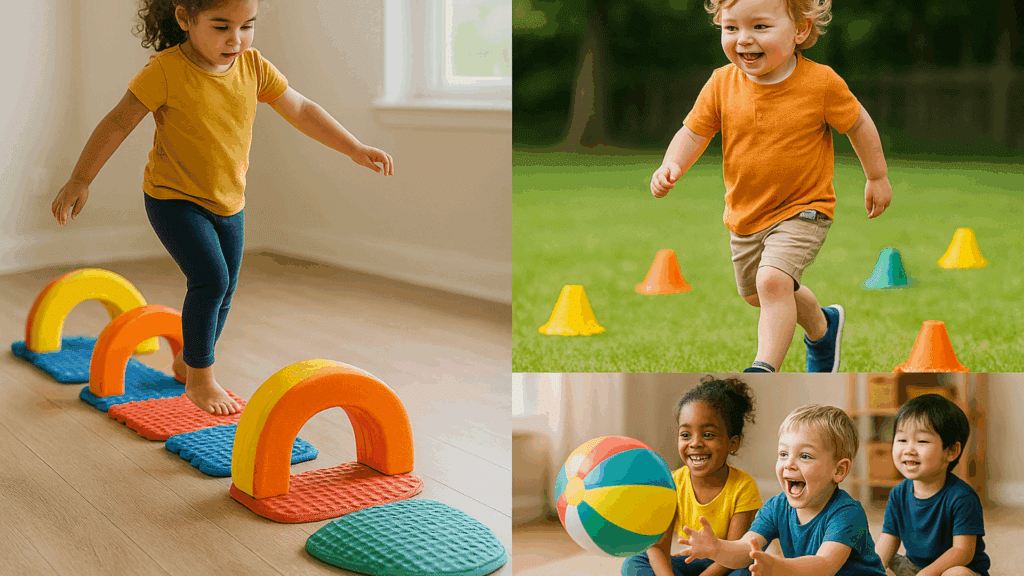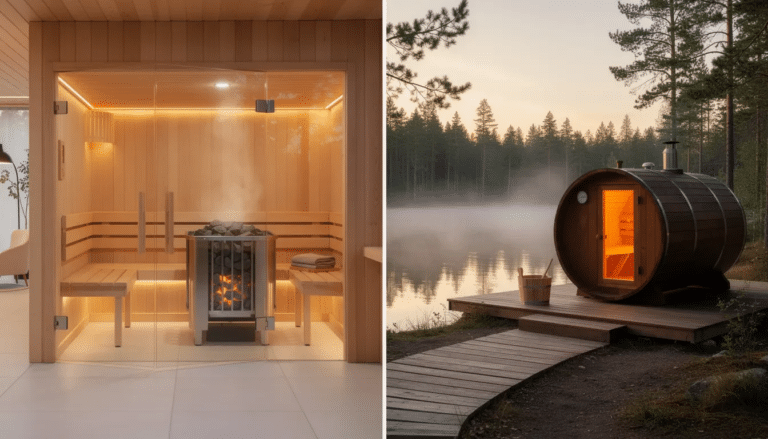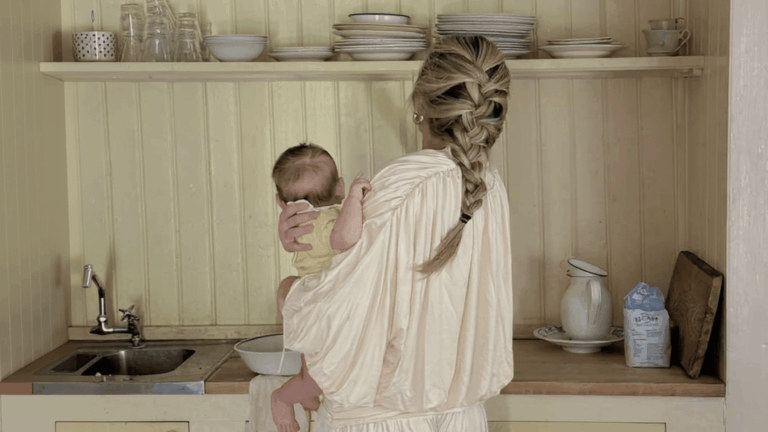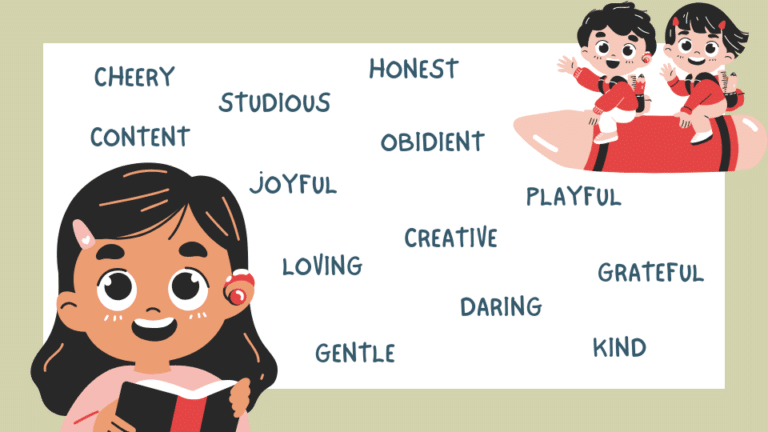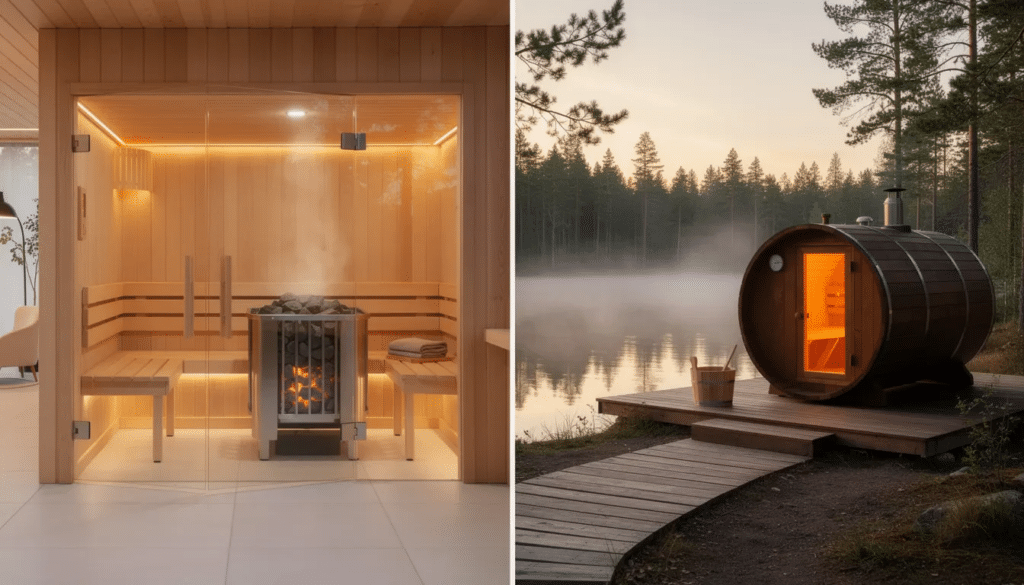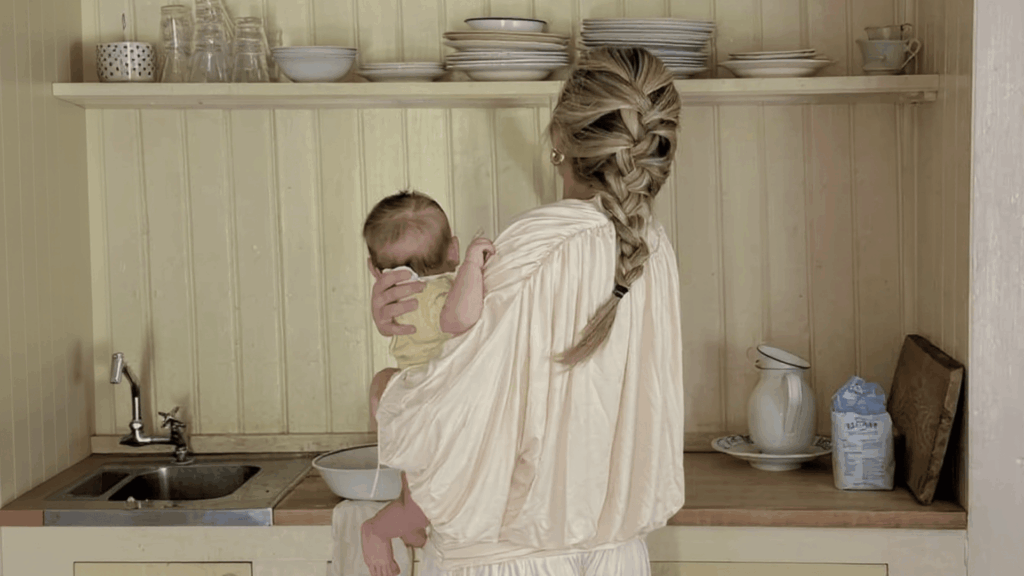Watch a preschooler try to sit still for more than five minutes. Their little bodies wiggle, bounce, and practically vibrate with energy that needs to go somewhere.
Many parents struggle to find activities that help their active preschoolers expend energy while developing essential physical skills.
Large motor activities for preschoolers, which can be done indoors or outdoors, require minimal setup and keep kids happily engaged.
When children get the physical movement they crave, they sleep better, focus longer, and feel more confident in their growing bodies.
What Are Large Motor Activities?
Large motor activities are physical movements that use the big muscles in a child’s body. These include the muscles in their arms, legs, back, and core.
Think of activities like running, jumping, climbing, throwing balls, or dancing.
These activities help preschoolers build strength and learn how to control their bodies. Large motor activities improve their balance, and they feel more confident moving around.
Large motor activities for preschoolers differ from fine motor skills, which utilize small muscles in the hands and fingers for tasks such as writing or buttoning shirts.
Both types of movement are essential, but large motor activities help children develop the foundation they need for all physical activities.
These activities also help kids release energy and feel happier throughout the day.
Large Motor Activities for Preschoolers
Large motor activities for preschoolers are fun physical movements that help young children build strong muscles, improve coordination, and burn off energy while learning essential skills they’ll use every day.
Indoor Activities
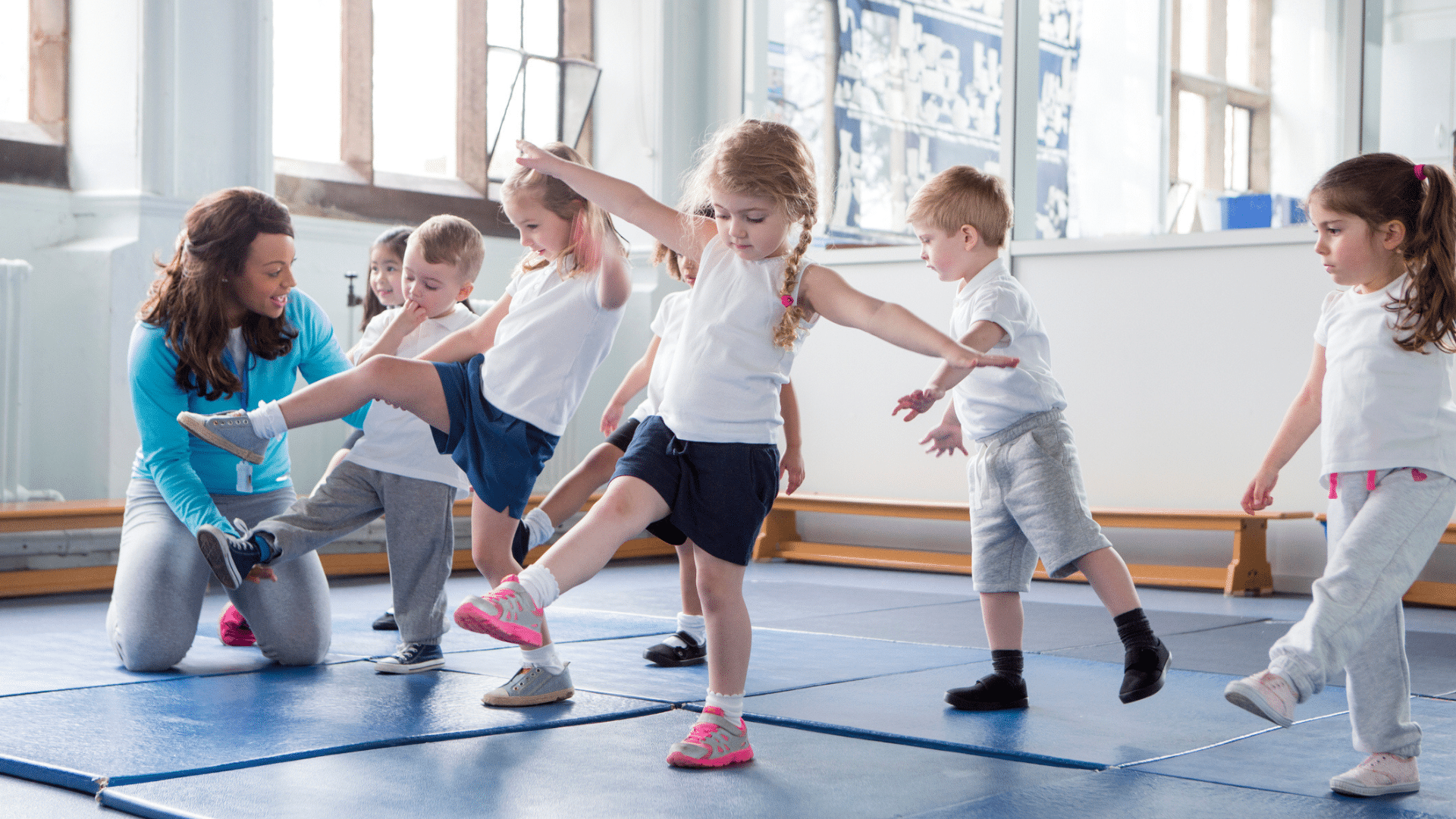
Indoor activities for preschoolers focus on big body movements like dancing, jumping, crawling, and stretching that can be done safely inside the house when outdoor play isn’t possible.
1. Bear Crawl Race
Children get on hands and knees and crawl like bears across the room. They keep their bottom up high and move forward using the opposite hand and foot. This activity builds core strength and coordination skills.
- Age: 3-5 years
- Effect: Strengthens shoulder muscles, improves bilateral coordination, and develops cross-lateral brain connections
2. Balloon Keep-Up
Kids work together to keep balloons floating in the air without letting them touch the ground. They can use their hands, feet, or head to tap the balloons upward. This game teaches teamwork and quick reactions.
- Age: 2-4 years
- Effect: Enhances hand-eye coordination, improves reaction time, and develops spatial awareness
3. Indoor Obstacle Course
Set up pillows to jump over, chairs to crawl under, and tape lines to walk on. Children move through each station following the path from start to finish. This activity challenges different movement patterns.
- Age: 3-6 years
- Effect: Develops problem-solving skills, improves motor planning, and builds confidence in movement
4. Yoga Animal Poses
Children copy animal movements like downward dog, cat stretch, and frog jumps. They hold each pose for a few seconds while breathing deeply. This practice combines movement with mindfulness.
- Age: 3-5 years
- Effect: Increases flexibility, improves balance, and develops body awareness and focus
5. Dancing Freeze Game
Kids dance freely to music and must freeze like statues when the music stops. They hold their position until the music starts again. This game teaches listening skills and body control.
- Age: 2-5 years
- Effect: Develops impulse control, improves listening skills, and strengthens core stability
6. Crawling Tunnel Race
Children crawl through play tunnels or under tables set up in a line. They move as fast as they can while staying low to the ground. This activity builds upper-body strength.
- Age: 3-5 years
- Effect: Strengthens arm and shoulder muscles, improves crawling patterns, and develops spatial orientation
7. Hopscotch Indoor Version
Use tape to create hopscotch squares on the floor for jumping practice. Children toss a small object and hop to retrieve it on one foot. This classic game improves balance and coordination.
- Age: 4-6 years
- Effect: Develops single-leg balance, improves jumping skills, and enhances number recognition
8. Scarf Juggling
Give children lightweight scarves to toss and catch in the air. They practice throwing one scarf up and catching it before it falls. This activity improves hand-eye coordination.
- Age: 3-5 years
- Effect: Enhances visual tracking, improves timing, and develops bilateral hand coordination
9. Marching Band Parade
Children march around the room while playing pretend instruments or shakers. They lift their knees high and swing their arms in rhythm. This activity combines music with movement.
- Age: 2-4 years
- Effect: Develops rhythm and timing, improves coordination, and strengthens leg muscles
10. Wall Push-Ups
Kids stand arm’s length from a wall and do push-ups against it. They place their hands flat on the wall and push their body away and back. This builds upper body strength safely.
- Age: 4-6 years
- Effect: Strengthens chest and arm muscles, improves posture, and develops upper body control
11. Simon Says Movement
One person gives movement commands like “Simon says touch your toes” or “Simon says hop on one foot.” Children only follow commands that start with “Simon says.” This game teaches listening and following directions.
- Age: 3-5 years
- Effect: Enhances listening skills, improves impulse control, and promotes body awareness.
12. Sock Skating
Children put on socks and pretend to ice skate on smooth floors. They glide and slide while trying to maintain balance and control. This activity is fun and helps with balance skills.
- Age: 3-6 years
- Effect: Develops balance and coordination, strengthens core muscles, and improves spatial awareness
13. Indoor Bowling
Set up plastic bottles or cups as bowling pins and roll a soft ball to knock them down. Children take turns trying to hit all the pins with their ball. This game improves aiming and rolling skills.
- Age: 3-5 years
- Effect: Develops hand-eye coordination, improves aim and accuracy, and teaches turn-taking
14. Crab Walk
Children sit on the floor, place their hands behind them, and lift their bodies to walk like crabs. They move forward, backward, and sideways while keeping their bottom off the ground. This strengthens multiple muscle groups.
- Age: 4-6 years
- Effect: Strengthens arms, core, and legs, improves coordination, and develops motor planning
15. Indoor Jumping Jacks
Children start with feet together and arms at their sides, then jump while spreading their legs and raising their arms overhead. They jump back to the starting position and repeat the movement. This classic exercise builds stamina.
- Age: 4-6 years
- Effect: Improves cardiovascular fitness, develops bilateral coordination, and strengthens multiple muscle groups
16. Pretend Swimming
Kids lie on their stomachs and move their arms and legs like they’re swimming different strokes. They can pretend to be different sea creatures while doing the movements. This activity works on coordination without water.
- Age: 3-5 years
- Effect: Develops bilateral coordination, strengthens core muscles, and improves motor planning
17. Indoor Hopscotch Variations
Create hopscotch patterns using different shapes, colors, or numbers on the floor. Children hop through the patterns following specific rules or sequences. This adds variety to the classic game.
- Age: 4-6 years
- Effect: Develops balance and coordination, improves number recognition, and enhances motor planning
18. Wheelbarrow Walks
One child holds another child’s feet while they walk forward on their hands. Partners switch roles so both children get to be the wheelbarrow. This activity requires cooperation and builds strength.
- Age: 4-6 years
- Effect: Strengthens upper body and core muscles, develops cooperation skills, and improves balance
19. Indoor Parachute Play
Children hold the edges of a large sheet or parachute and move it up and down together. They can put lightweight balls on top and try to bounce them off. This activity requires teamwork.
- Age: 3-6 years
- Effect: Develops cooperation skills, improves bilateral coordination, and strengthens arm muscles
20. Balance Beam Walking
Use a piece of tape on the floor or a low wooden beam for children to walk across. They can walk forward, backward, or sideways while keeping their balance. This activity challenges stability skills.
- Age: 3-6 years
- Effect: Develops balance and coordination, improves concentration, and strengthens core muscles
21. Indoor Basketball
Set up a low basketball hoop or use a laundry basket for children to shoot soft balls into. They practice different shooting techniques and distances. This game improves aiming and throwing skills.
- Age: 4-6 years
- Effect: Develops hand-eye coordination, improves throwing accuracy, and builds upper body strength
Outdoor Large Motor Activities for Preschoolers
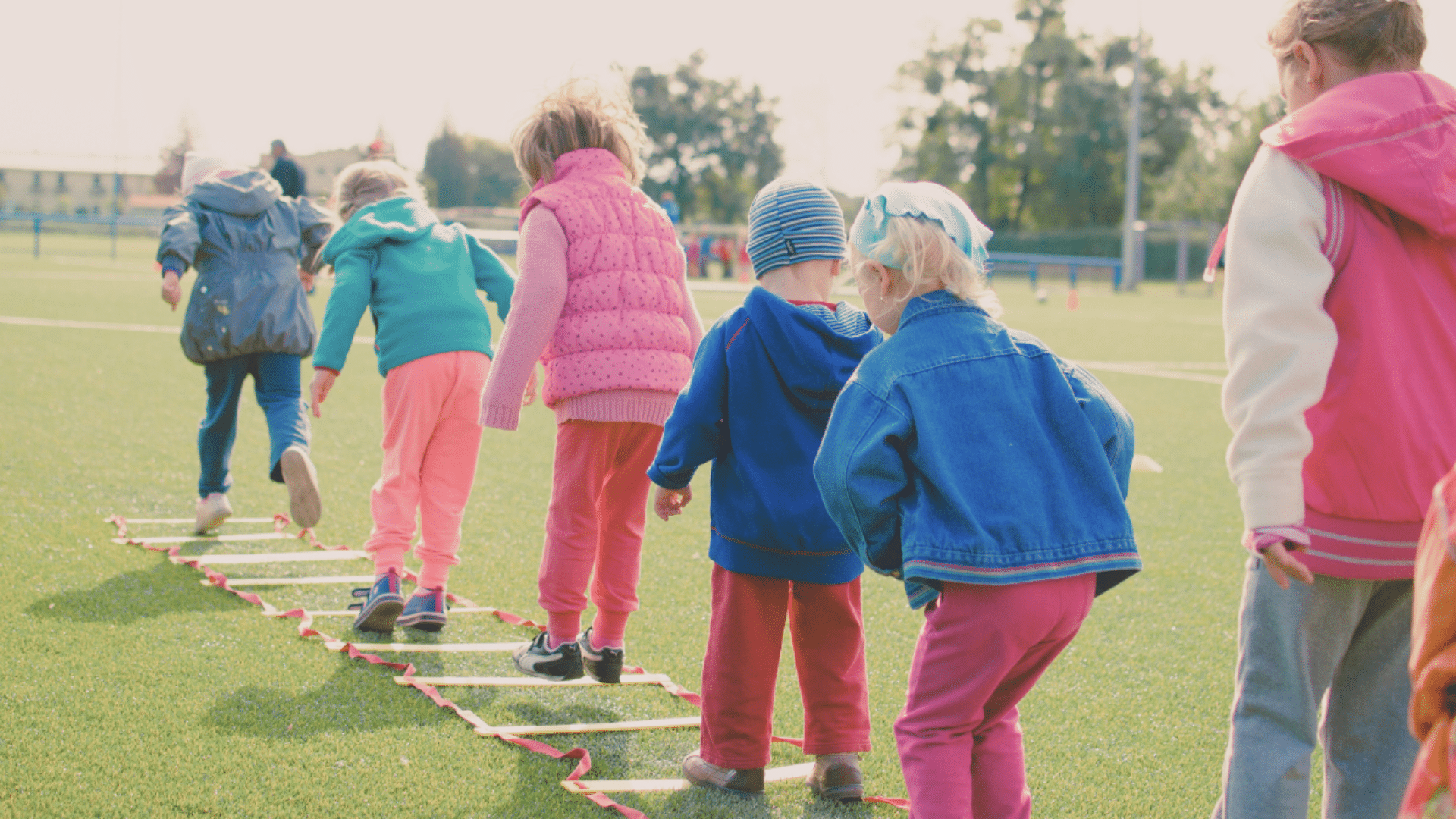
Outdoor spaces provide preschoolers with room to run, jump, climb, and play games that build strong muscles and coordination while enjoying the fresh air and sunshine.
22. Running Races
Children run from one point to another as fast as they can. They can race against friends or try to beat their own time. This simple activity builds cardiovascular fitness and leg strength.
- Age: 3-6 years
- Effect: Improves cardiovascular fitness, develops leg strength, and enhances competitive spirit
23. Playground Climbing
Kids climb on jungle gyms, monkey bars, and climbing structures at the playground. They use different muscle groups to pull themselves up and across equipment. This activity builds total body strength.
- Age: 4-6 years
- Effect: Strengthens upper body and core muscles, improves grip strength, and develops problem-solving skills
24. Jump Rope Practice
Children learn to jump over a rope that’s turned by others or themselves. They start with basic jumping and can progress to more complex patterns. This activity improves timing and coordination.
- Age: 5-6 years
- Effect: Develops coordination and timing, improves cardiovascular fitness, and strengthens leg muscles
25. Tag Games
One child chases others and tries to tag them before they reach a safe zone. Tagged children become “it” and chase the other players. This classic game builds running skills and social interaction.
- Age: 3-6 years
- Effect: Improves running speed and agility, develops social skills, and enhances cardiovascular fitness
26. Nature Hikes
Children walk on trails while looking for different plants, animals, and natural objects. They can collect leaves, rocks, or flowers during their exploration. This activity combines exercise with learning.
- Age: 3-6 years
- Effect: Develops endurance and leg strength, improves observation skills, and connects children with nature
27. Sidewalk Chalk Hopscotch
Draw hopscotch squares on the sidewalk with colorful chalk for outdoor jumping fun. Children can create their own patterns and rules for the game. This activity encourages creativity and movement.
- Age: 4-6 years
- Effect: Develops balance and jumping skills, encourages creativity, and improves number recognition
28. Water Balloon Toss
Children throw water balloons back and forth with partners, trying not to let them break. They step further apart with each successful catch. This summer activity is fun and cooling.
- Age: 4-6 years
- Effect: Improves hand-eye coordination, develops catching skills, and provides sensory experience
29. Tricycle Racing
Kids ride tricycles around a designated course or path as fast as they safely can. They can race against friends or practice different riding skills. This activity builds leg strength and balance.
- Age: 2-4 years
- Effect: Develops leg strength and coordination, improves balance, and enhances spatial awareness
30. Outdoor Obstacle Course
Set up cones to weave through, logs to jump over, and hills to climb. Children move through the course using different skills at each station. This activity challenges various movement abilities.
- Age: 4-6 years
- Effect: Develops agility and coordination, improves problem-solving skills, and builds confidence
31. Sand and Water Play
Children dig, pour, and build with sand and water using various tools and containers. They can create castles, rivers, or mountains while getting messy. This sensory activity is both fun and educational.
- Age: 2-5 years
- Effect: Develops fine and gross motor skills, provides sensory input, and encourages creativity
32. Frisbee Throwing
Kids learn to throw and catch frisbees with friends or family members. They practice different throwing techniques and try to catch the disc before it hits the ground. This activity improves coordination.
- Age: 5-6 years
- Effect: Develops hand-eye coordination, improves throwing and catching skills, and builds upper body strength
33. Bubble Chasing
Children run around trying to pop bubbles that are blown into the air. They jump, reach, and chase the bubbles before they float away or pop. This activity is joyful and gets kids moving.
- Age: 2-4 years
- Effect: Improves hand-eye coordination, develops jumping skills, and provides visual tracking practice
34. Soccer Dribbling
Kids practice moving a soccer ball with their feet while walking or running. They learn to control the ball and keep it close to their body. This activity builds foot coordination and leg strength.
- Age: 4-6 years
- Effect: Develops foot-eye coordination, improves balance, and strengthens leg muscles
35. Scavenger Hunt Walking
Children walk around the yard or park looking for specific items on a list. They might search for different colored leaves, smooth rocks, or specific flowers. This activity combines movement with observation.
- Age: 3-6 years
- Effect: Develops observation skills, improves endurance, and encourages exploration
36. Sprinkler Running
Kids run through sprinklers or water from a hose on hot days. They jump over the water streams and get soaked while staying cool. This activity is refreshing and energizing.
- Age: 2-6 years
- Effect: Provides cardiovascular exercise, offers sensory experience, and helps with temperature regulation
37. Flying Kites
Children hold kite strings and run to get their kites airborne on windy days. They learn to control the kite’s movement by adjusting the string tension. This activity teaches cause and effect.
- Age: 4-6 years
- Effect: Develops hand coordination, improves understanding of wind and movement, and builds patience
38. Playground Swinging
Kids pump their legs to make swings go higher and practice different swinging techniques. They learn to coordinate their body movements to maintain momentum. This activity provides vestibular input.
- Age: 3-6 years
- Effect: Develops core strength, provides vestibular stimulation, and improves rhythmic coordination
39. Outdoor Dancing
Children dance to music played outside, using the open space for bigger movements. They can create their own dance moves or follow along with songs. This activity combines music with physical activity.
- Age: 2-6 years
- Effect: Improves coordination and rhythm, develops creativity, and provides cardiovascular exercise
40. Hill Rolling
Kids lie down and roll down grassy hills, controlling their speed and direction. They experience different body positions and vestibular sensations while having fun. This activity provides sensory input.
- Age: 3-5 years
- Effect: Provides vestibular stimulation, develops spatial awareness, and offers sensory experience
41. Red Light Green Light
One person calls out “green light” for running and “red light” for stopping immediately. Children must freeze when they hear the word “red light” and run when they hear the word “green light.” This game teaches listening and control.
- Age: 3-5 years
- Effect: Develops impulse control, improves listening skills, and provides cardiovascular exercise
42. Outdoor Yoga
Children practice yoga poses in the fresh air, connecting with nature while stretching. They can imitate animals or create their own poses inspired by outdoor surroundings. This activity promotes mindfulness.
- Age: 4-6 years
- Effect: Increases flexibility, develops balance, and promotes mindfulness and body awareness
43. Tug of War
Two teams pull on opposite ends of a rope, trying to pull the other team across a line. Children work together and use their whole body strength to win. This activity builds teamwork and strength.
- Age: 4-6 years
- Effect: Develops teamwork skills, builds total body strength, and improves grip strength
Easy Tips for Leading Movement Activities
Creating successful large motor play experiences helps children develop physical skills while having fun. These practical tips will help parents and teachers set up activities that keep kids engaged and moving safely.
- Create Safe Play Spaces: Clear away toys and furniture to make plenty of room for children to move around without risk of injury.
- Start Simple and Build Up: Begin with easy movements, such as marching, and then add more challenging activities, like jumping, once the kids feel confident.
- Offer Positive Encouragement: Praise children for trying hard, rather than expecting perfection, which helps them want to continue playing and learning.
- Include All Skill Levels: Adjust activities to be easier or harder so that every child can join in and feel successful, regardless of their ability.
- Focus on Fun, Not Competition: Keep activities playful and enjoyable rather than worrying about who wins or does best.
- Use Age-Appropriate Equipment: Choose soft, lightweight balls and tools that are easy for small hands to hold and use safely.
- Give Children Choices: Let kids pick which activity they want to do from a few options to keep them interested and excited.
Bottom Line
Those wiggly, energetic preschoolers bouncing off the walls? They’re showing parents exactly what they need: more chances to move those big muscles and burn off all that natural energy.
Some parents might still worry about finding time for these activities or think they need special equipment to make movement fun for their little ones.
The truth is, large motor activities for preschoolers don’t have to be complicated or time-consuming.
When children get enough movement throughout their day, bedtime becomes easier, focus improves, and everyone feels happier. Most of these activities cost nothing and can happen right in the living room.
What’s been the biggest hit with the kids? Comment below and let other parents know!


